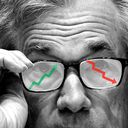Bond market moves imply a slowdown ahead

A riddle: When does a report showing a booming job market cause recession alarm bells to start clanging?
- The answer is when exceptional jobs growth leads bond investors to bet that the Federal Reserve will raise rates so aggressively to quash inflation that it will be forced to reverse course later. That's what happened Friday.
Why it matters: When the bond yield curve inverts, as it did Friday, it's traditionally a harbinger of recession. And while that's getting well ahead of things, it's clear the Fed is on an increasingly narrow tightrope.
State of play: The March employment data was terrific, with 431,000 jobs added, positive revisions to January and February and a falling jobless rate. More Americans joined the labor market, and wages showed solid growth.
- Just two weeks before, Fed chair Jerome Powell said that he sees a "very, very tight labor market, tight to an unhealthy level." The new numbers, especially around the unemployment rate, suggest it is becoming even more so.
- That means the jobs numbers amount to a green light for more aggressive tightening, including what looks likely to be the first half-percentage point rate hike in 22 years at a policy meeting that will conclude May 4.
The market reaction: That's why the jobs numbers caused an upward surge in two-year Treasury yields, to 2.46% from 2.28%. Longer-term yields rose by less, with the 10-year ending the day at 2.38%.
- When long-term rates are lower than short-term rates, that's an inversion. Essentially, bond investors are betting that the Fed will end up reversing those near-term rate hikes down the road, presumably because of a weakening economy.
What they're saying: Even relatively dovish members of the Fed's policy committee are gearing up for more aggressive rate hikes.
- “The case for 50 [basis points], barring any negative surprise between now and the next meeting, has grown,” San Francisco Fed president Mary Daly, generally a monetary dove, told the FT in an interview on Friday.
- New York Fed president John Williams said in a speech Saturday that the Fed's tightening "will help bring demand for labor and products in closer alignment with available supply."
Yes, but: The recession talk appears premature. Current bond prices do imply slower growth ahead, but do not currently suggest the Fed will overdo its tightening campaign so much as to face outright economic contraction in the near future.
- The five-year yield remains higher than the two-year yield, which is not consistent with a recession in the medium-term.
- And the Atlanta Fed's calculations of markets' expected path of the federal funds rate has the Fed policy rate peaking near 3% in the fall of 2023, before drifting downward toward only to 2.5% by the spring of 2025.
None of that suggests a 1980s Paul Volcker-era strategy of hiking rates to effectively crush the economy is likely. Markets are pricing in something closer to the Fed's successful "mid-cycle adjustment" rate cuts of 2019 that followed the last yield curve inversion.
- Still, there are wide error bands around those market estimates, and it's not as if bond traders have perfect forecasting ability. We still don't know exactly what the economic cost of bringing inflation down will be.
The bottom line: As Williams put it in his speech Saturday, "One of the things we've learned from the pandemic is to expect the unexpected."